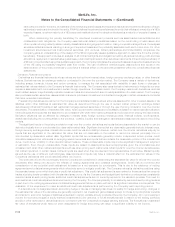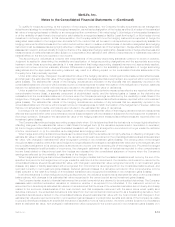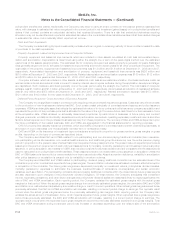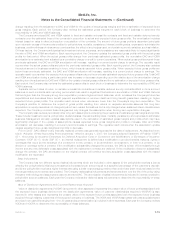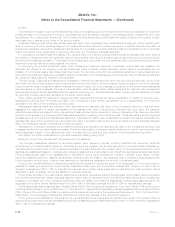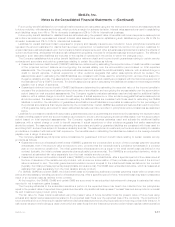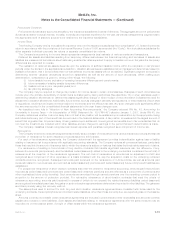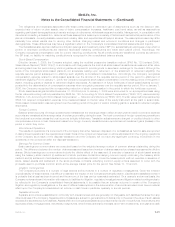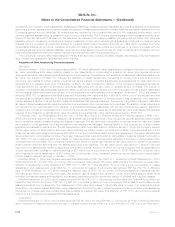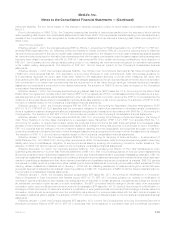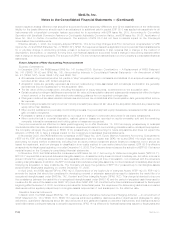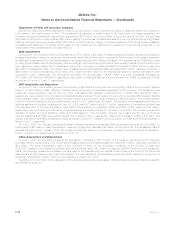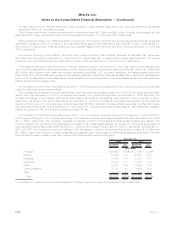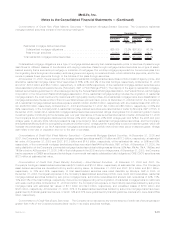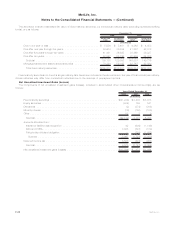MetLife 2008 Annual Report Download - page 145
Download and view the complete annual report
Please find page 145 of the 2008 MetLife annual report below. You can navigate through the pages in the report by either clicking on the pages listed below, or by using the keyword search tool below to find specific information within the annual report.equivalents. The Company reports separately, as assets and liabilities, investments held in separate accounts and liabilities of the separate
accounts if (i) such separate accounts are legally recognized; (ii) assets supporting the contract liabilities are legally insulated from the
Company’s general account liabilities; (iii) investments are directed by the contractholder; and (iv) all investment performance, net of
contract fees and assessments, is passed through to the contractholder. The Company reports separate account assets meeting such
criteria at their fair value which is based on the estimated fair values of the underlying assets comprising the portfolios of an individual
separate account. Investment performance (including investment income, net investment gains (losses) and changes in unrealized gains
(losses)) and the corresponding amounts credited to contractholders of such separate accounts are offset within the same line in the
consolidated statements of income. Separate accounts not meeting the above criteria are combined on a line-by-line basis with the
Company’s general account assets, liabilities, revenues and expenses and the accounting for these investments is consistent with the
methodologies described herein for similar financial instruments held within the general account.
The Company’s revenues reflect fees charged to the separate accounts, including mortality charges, risk charges, policy administration
fees, investment management fees and surrender charges.
Adoption of New Accounting Pronouncements
Fair Value
Effective January 1, 2008, the Company adopted SFAS 157 which defines fair value, establishes a consistent framework for measuring
fair value, establishes a fair value hierarchy based on the observability of inputs used to measure fair value, and requires enhanced
disclosures about fair value measurements and applied the provisions of the statement prospectively to assets and liabilities measured at
fair value. The adoption of SFAS 157 changed the valuation of certain freestanding derivatives by moving from a mid to bid pricing
convention as it relates to certain volatility inputs as well as the addition of liquidity adjustments and adjustments for risks inherent in a
particular input or valuation technique. The adoption of SFAS 157 also changed the valuation of the Company’s embedded derivatives,
most significantly the valuation of embedded derivatives associated with certain riders on variable annuity contracts. The change in
valuation of embedded derivatives associated with riders on annuity contracts resulted from the incorporation of risk margins associated
with non capital market inputs and the inclusion of the Company’s own credit standing in their valuation. At January 1, 2008, the impact of
adopting SFAS 157 on assets and liabilities measured at estimated fair value was $30 million ($19 million, net of income tax) and was
recognized as a change in estimate in the accompanying consolidated statement of income where it was presented in the respective
income statement caption to which the item measured at estimated fair value is presented. There were no significant changes in estimated
fair value of items measured at fair value and reflected in accumulated other comprehensive income (loss). The addition of risk margins and
the Company’s own credit spread in the valuation of embedded derivatives associated with annuity contracts may result in significant
volatility in the Company’s consolidated net income in future periods. Note 24 presents the estimated fair value of all assets and liabilities
required to be measured at estimated fair value as well as the expanded fair value disclosures required by SFAS 157.
In February 2007, the FASB issued SFAS No. 159, The Fair Value Option for Financial Assets and Financial Liabilities (“SFAS 159”).
SFAS 159 permits entities the option to measure most financial instruments and certain other items at fair value at specified election dates
and to recognize related unrealized gains and losses in earnings. The fair value option is applied on an instrument-by-instrument basis
upon adoption of the standard, upon the acquisition of an eligible financial asset, financial liability or firm commitment or when certain
specified reconsideration events occur. The fair value election is an irrevocable election. Effective January 1, 2008, the Company elected
the fair value option on fixed maturity and equity securities backing certain pension products sold in Brazil. Such securities will now be
presented as trading securities in accordance with SFAS 115 on the consolidated balance sheet with subsequent changes in estimated fair
value recognized in net investment income. Previously, these securities were accounted for as available-for-sale securities in accordance
with SFAS 115 and unrealized gains and losses on these securities were recorded as a separate component of accumulated other
comprehensive income (loss). The Company’s insurance joint venture in Japan also elected the fair value option for certain of its existing
single premium deferred annuities and the assets supporting such liabilities. The fair value option was elected to achieve improved
reporting of the asset/liability matching associated with these products. Adoption of SFAS 159 by the Company and its Japanese joint
venture resulted in an increase in retained earnings of $27 million, net of income tax, at January 1, 2008. The election of the fair value
option resulted in the reclassification of $10 million, net of income tax, of net unrealized gains from accumulated other comprehensive
income (loss) to retained earnings on January 1, 2008.
Effective January 1, 2008, the Company adopted FASB Staff Position (“FSP”) No. FAS 157-1, Application of FASB Statement No. 157 to
FASB Statement No. 13 and Other Accounting Pronouncements That Address Fair Value Measurements for Purposes of Lease Clas-
sification or Measurement under Statement 13 (“FSP 157-1”). FSP 157-1 amends SFAS 157 to provide a scope out exception for lease
classification and measurement under SFAS No. 13, Accounting for Leases. The Company also adopted FSP No. FAS 157-2, Effective
Date of FASB Statement No. 157 which delays the effective date of SFAS 157 for certain nonfinancial assets and liabilities that are
recorded at fair value on a nonrecurring basis. The effective date is delayed until January 1, 2009 and impacts balance sheet items
including nonfinancial assets and liabilities in a business combination and the impairment testing of goodwill and long-lived assets.
Effective September 30, 2008, the Company adopted FSP No. FAS 157-3, Determining the Fair Value of a Financial Asset When the
Market for That Asset is Not Active (“FSP 157-3”). FSP 157-3 provides guidance on how a company’s internal cash flow and discount rate
assumptions should be considered in the measurement of fair value when relevant market data does not exist, how observable market
information in an inactive market affects fair value measurement and how the use of market quotes should be considered when assessing
the relevance of observable and unobservable data available to measure fair value. The adoption of FSP 157-3 did not have a material
impact on the Company’s consolidated financial statements.
Investments
Effective December 31, 2008, the Company adopted FSP No. FAS 140-4 and FIN 46(r)-8, Disclosures by Public Entities (Enterprises)
about Transfers of Financial Assets and Interests in Variable Interest Entities (“FSP 140-4 and FIN 46(r)-8”). FSP 140-4 and FIN 46(r)-8
F-22 MetLife, Inc.
MetLife, Inc.
Notes to the Consolidated Financial Statements — (Continued)


